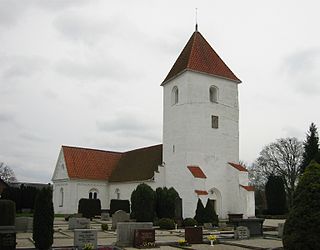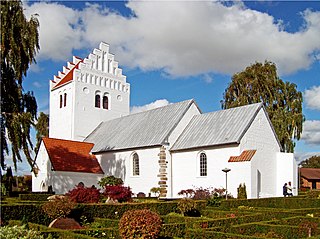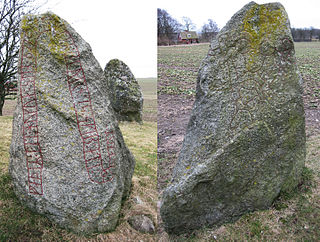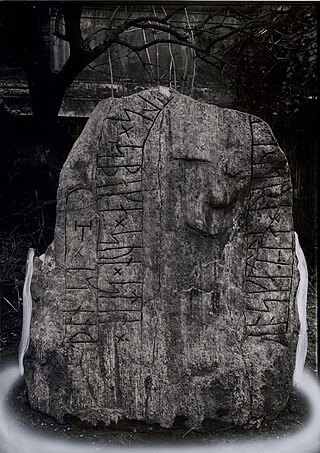
Danish Runic Inscription 66 or DR 66, also known as the Mask stone, is a granite Viking Age memorial runestone that was discovered in Aarhus, Denmark. The inscription features a facial mask and memorializes a man who died in a battle.

The Hällestad Runestones are three runestones located in the walls of Hällestad Church in Torna-Hällestad, about 20 kilometers east of Lund in Skåne, southern Sweden. Their Rundata identifiers are DR 295, 296, and 297. DR 295 is notable because it is held to be raised in memory of a warrior who fell in the legendary Battle of the Fýrisvellir, near Uppsala, Sweden between the Jomsvikings led by Styrbjörn the Strong and Styrbjörn's uncle Eric the Victorious, the king of Sweden, c. 985. The other stones were raised by the same people, and they probably formed a monument together in memory of comrades lost in the battle. The Karlevi Runestone, the Egtved Runestone and the Sjörup Runestone may be connected to them.

Egå is a both a suburban district and a stream in the Municipality of Aarhus in Denmark.

The Kallerup Stone, designated as runic inscription DR 250 in the Rundata system, is a memorial runestone which is located in Hedehusene, Høje-Taastrup Municipality, on the island of Zealand in eastern Denmark. It is among the oldest runestones in Denmark.

The Lund 1 Runestone, designated as DR 314 in the Rundata catalog, is a Viking Age memorial runestone originally located on the grounds of the All Saints Church in Lund, Scania, Sweden.

The Eltang stone (also Stenderup stone, listed as DR 35 in the Rundata catalog, is a Viking Age runestone . The stone was discovered in 1866 at North-Stenderup, Eltang parish, Kolding Municipality, Region of Southern Denmark, Denmark, about 2 km northeast of Kolding, on the estate of one Mr. Flensbourg, who gave it to the Oldnordisk Museum.

The Västra Strö 2 Runestone, listed as DR 335 in the Rundata catalog, is a Viking Age memorial runestone located at the Västra Strö Monument, which is at a church that is about four kilometers northwest of Eslöv, Skåne County, Sweden.

The Skern Runestone, designated as Danish Runic Inscription 81 or DR 81 in the Rundata catalog, is a Viking Age memorial runestone located in the small village of Skjern, Denmark between Viborg and Randers. The stone features a facial mask and a runic inscription which ends in a curse. A fragment of a second runestone designated as DR 80 was also found in Skjern.

The Sjellebro Stone is a Viking Age image stone located at Sjellbro, which is about 12 kilometers southeast of Randers, Denmark. The stone is inscribed with a facial mask.

The Bjäresjö Runestones are three Viking Age memorial runestones originally located adjacent to Bjäresjö Church in Bjäresjö, which is about 3 kilometers northwest of Ystad, Skåne County, Sweden. Two of the stones were discovered near the church, and two of the stones have been moved to other nearby locations. Although these three stones are located in Sweden, they have been given Danish designations because Scania was part of the historic Denmark.

The Ålum Runestones are four Viking Age memorial runestones which are located at the church in Ålum, which is 9 km west of Randers, Denmark. One of the stones refers to a man with the title drengr and two of the other stones were raised by the same family.

The Asferg Runestone, listed as DR 121 in the Rundata catalog, is a Viking Age memorial runestone found at Asferg, which is about 10 km northeast of Randers, Aarhus County, Region Midtjylland, Denmark.

The Aars stone or DR 131 is a late Viking Age runestone located on a mound in the churchyard at Aars in Himmerland, Denmark. Dated to the late 10th to early 11th century, it bears an inscription in the Younger Fuþark in memory of Toke Gormsson, known as Valtoke, who died at the Battle of Fýrisvellir.

DR 110, or the Virring stone, is a runestone made of granite that measures 155 cm (61 in) in height, 120 cm (47 in) in width and 27 cm (11 in) in thickness. It is written in Old East Norse in the Younger Futhark, and the runestone style is in a form called RAK.

The Sønder Vinge stone 2 or DR 83 is a Viking Age runestone engraved in Old Norse with the Younger Futhark runic alphabet. The stone is in granite and was discovered in 1866 as a corner stone of Sønder Vinge Church, positioned with the runic inscription outwards. It is presently located in the porch of the church. It is probably from the period 970-1020 due to runic and linguistic features. It is 180 cm tall, 132 cm wide and 35 cm thick. Parts of the runic inscription have eroded which makes some runes hard to read. The style of the runestone is the runestone style RAK.

The Sædinge Runestone or DR 217 is a Viking Age runestone engraved in Old Norse with the Younger Futhark runic alphabet. It is in granite and measures 174 cm in height, 79 m in width and it is 69 cm thick, and it is dated to the period 970–1020. The style of the runestone is the runestone style RAK. It was discovered in 1854, during the plowing of a field near an old ford. However, it was split in nine pieces and spread around before it was noticed that there were runes on them. It took several searches to find all the pieces. Only the top piece is missing but it is known from an old drawing. The stone is presently located at the Stiftsmuseum in Maribo on Lolland, Denmark. In 2014, it was moved inside the building.

The Egtved Runestone or DR 37 is a Viking Age runestone engraved in Old Norse with the Younger Futhark runic alphabet. It was discovered in 1863, by a master mason named Anders Nielsen from Starup, in the southern part of the cemetery of Egtved church. It is dated to the period 900–1020. The stone is in granite and measures 80 cm in height, 55 cm in width and 43 cm in thickness. The style of the runestone is the runestone style RAK.
The Tvorup/Torup stone or DR 154 † was a Viking Age runestone engraved in Old Norse with the Younger Futhark runic alphabet, which has disappeared. According to Skonvig the stone would have been located just inside the door of church of Torup, having been moved there from a mound east of the church. The stone must have been lost while being transported to Copenhagen because nothing more is known about it. Skonvig reported that the stone was 2.5 Danish ells high and 1 ell wide. It was made by the same runemaster who made DR 155, and Lerche Nielsen (2010:244f) suggests that the two stones may actually be the same stone. The stone is dated to the period 970–1020, and the style of the runestone was the runestone style RAK.

The Fuglie stone 1 or DR 259 is a Viking Age runestone engraved in Old Norse with the Younger Futhark runic alphabet. It was first mentioned by Skonvig and it is still located in its original location on a Nordic Bronze Age mound next to the church of Fuglie, Skåne, Sweden. There are many local legends and traditions about the stone. The stone is 105 cm tall, 63 cm wide, and 33 cm thick. The stone is dated to the period 970–1020, and the style of the runestone was the runestone style RAK.

Runestone DR 120, MJy 51, known as Spentrup stone 2 and the Jennum stone, is a Viking Age runestone engraved with the Younger Futhark and a Thor's hammer.



















